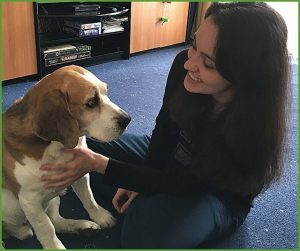4 things I learned from pet sitting...
 In one of the recent emails/blogs I sent you, I wrote, “animals are our best teachers”. I’ve heard this said at many conferences, in many web classes, and during many conversations with other behaviour geeks. This is also part of why I love pet sitting so much! I can learn a lot from the animals I’m taking care of! Consequently, I wanted to share four things I recently learned while pet sitting the amazing Odie the beagle.
In one of the recent emails/blogs I sent you, I wrote, “animals are our best teachers”. I’ve heard this said at many conferences, in many web classes, and during many conversations with other behaviour geeks. This is also part of why I love pet sitting so much! I can learn a lot from the animals I’m taking care of! Consequently, I wanted to share four things I recently learned while pet sitting the amazing Odie the beagle.
1. Animals are stacking the odds in their favour…
I noticed something interesting when I was taking Odie out for a walk. When I had treats with me, Odie was likely to stop and wait for me to throw one for him. How did that happen? Well… I accidentally trained it! OR you might say that he taught me! He is far more patient than I am, and when he stopped [and I needed to go], I started to throw food in front of us. He very quickly learned that stopping makes me throw food. Dogs are fantastic at teaching us what they would like us to do!
2. Something in the environment is cueing the behaviour in question.
I observed that the behaviour of stopping behind me is likely to happen at the beginning of the walk when I have my treat pouch with me. Then at some point, Odie will get interested in the environment, go sniff and consequently, he stops cueing me to throw him food. [He is cueing me by stopping behind me and looking at me].
What is the one way I can avoid Odie stopping at the beginning of the walk? -> Don’t bring my treat pouch with me! He looks at me; he sees that I don’t have my treat pouch, and he starts walking without a problem!
3. Change the strategy you use to suit different situations.
I tried another approach to get Odie to keep moving at the start of walks. I did this when Odie became my fabulous dog training partner during a session with a client [the clients dog is one whom I might label as ‘reactive’ to other male dogs].
 While having my treat pouch, I increased my reinforcement rate and changed the reinforcement placement by feeding next to my knee. With a higher reinforcement rate, I reinforced Odie walking next to me more and avoiding stopping behind me. He responded very well! I also wanted Odie to focus on me, not the other dog. I tried to catch him looking at me and making steps whenever I could. In the end, he was a fabulous addition to the training with the so-called ‘reactive’ dog. The change in the other dog was excellent also, and we could do a one hour walk next to each other.
While having my treat pouch, I increased my reinforcement rate and changed the reinforcement placement by feeding next to my knee. With a higher reinforcement rate, I reinforced Odie walking next to me more and avoiding stopping behind me. He responded very well! I also wanted Odie to focus on me, not the other dog. I tried to catch him looking at me and making steps whenever I could. In the end, he was a fabulous addition to the training with the so-called ‘reactive’ dog. The change in the other dog was excellent also, and we could do a one hour walk next to each other.
I find it empowering to know that I can either not take any treats with me or use a high reinforcement rate, and both strategies can work. I don’t want to do training on every single walk with Odie. I want him to explore the environment too. Looking at a beagle using his nose and tracking some mysterious [to me] odours is quite fascinating! I don’t want to train throughout the whole walk – I want him to explore his fascinating world of scent.
4. Assess the specific conditions under which the behaviour is happening
Another interesting observation I explored is how Odie reacts to cats. I observed he completely ignored cats when they were still and above him. However, when we met a ‘moving cat’, Odie started barking and wanted to go after them. Then, when he realised that the cat was behind a barrier and stopped running – Odie ignored them again. What did I learn from this situation?
Under the conditions that the cat is moving and stays on the level of Odie’s eyes – he is likely to try and chase the cat. When there is a barrier between them, Odie will likely give up faster. And Odie would not react when the cat is not moving and is on a higher level or far away.
This experience reminded me that it’s essential to identify what your learners are doing when interpreting behaviour, but it’s equally important to know under which conditions it is happening. So, for example, if the cat is not moving, then Odie is far less likely to react – that’s valuable information that can help us develop a training plan [if one wishes to change this behaviour].
How about you? Did your dog train you to do something? Have you done pet-sitting before [what did you learn]? I would love to hear your stories and you can leave a comment below!
Best Regards
Anna Bartosik (Blog Writer & ATA Happiness Engineer) &
Ryan Cartlidge (Blog Editor & ATA Founder/Connector/Facilitator).